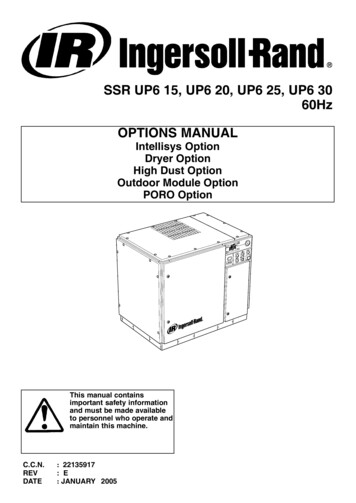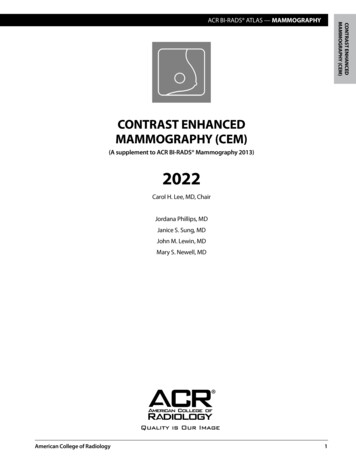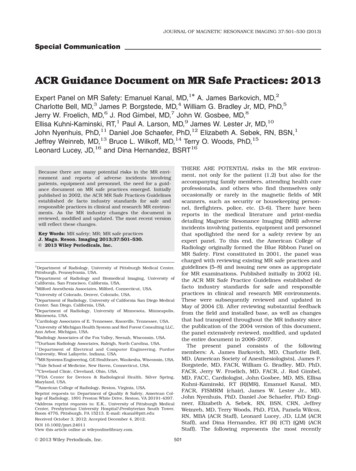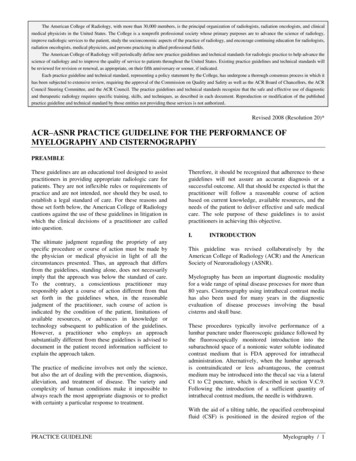
Transcription
The American College of Radiology, with more than 30,000 members, is the principal organization of radiologists, radiation oncologists, and clinicalmedical physicists in the United States. The College is a nonprofit professional society whose primary purposes are to advance the science of radiology,improve radiologic services to the patient, study the socioeconomic aspects of the practice of radiology, and encourage continuing education forradiologists, radiation oncologists, medical physicists, and persons practicing in allied professional fields.The American College of Radiology will periodically define new practice parameters and technical standards for radiologic practice to help advance thescience of radiology and to improve the quality of service to patients throughout the United States. Existing practice parameters and technical standardswill be reviewed for revision or renewal, as appropriate, on their fifth anniversary or sooner, if indicated.Each practice parameter and technical standard, representing a policy statement by the College, has undergone a thorough consensus process in which it hasbeen subjected to extensive review and approval. The practice parameters and technical standards recognize that the safe and effective use of diagnosticand therapeutic radiology requires specific training, skills, and techniques, as described in each document. Reproduction or modification of the publishedpractice parameter and technical standard by those entities not providing these services is not authorized.Revised 2018 (Resolution 19)*ACR–ASNR–SCBT-MR–SSR PRACTICE PARAMETER FOR THEPERFORMANCE OF MAGNETIC RESONANCE IMAGING (MRI) OF THEADULT SPINEPREAMBLEThis document is an educational tool designed to assist practitioners in providing appropriate radiologic care forpatients. Practice Parameters and Technical Standards are not inflexible rules or requirements of practice and arenot intended, nor should they be used, to establish a legal standard of care1. For these reasons and those set forthbelow, the American College of Radiology and our collaborating medical specialty societies caution against theuse of these documents in litigation in which the clinical decisions of a practitioner are called into question.The ultimate judgment regarding the propriety of any specific procedure or course of action must be made by thepractitioner in light of all the circumstances presented. Thus, an approach that differs from the guidance in thisdocument, standing alone, does not necessarily imply that the approach was below the standard of care. To thecontrary, a conscientious practitioner may responsibly adopt a course of action different from that set forth in thisdocument when, in the reasonable judgment of the practitioner, such course of action is indicated by the conditionof the patient, limitations of available resources, or advances in knowledge or technology subsequent topublication of this document. However, a practitioner who employs an approach substantially different from theguidance in this document is advised to document in the patient record information sufficient to explain theapproach taken.The practice of medicine involves not only the science, but also the art of dealing with the prevention, diagnosis,alleviation, and treatment of disease. The variety and complexity of human conditions make it impossible toalways reach the most appropriate diagnosis or to predict with certainty a particular response to treatment.Therefore, it should be recognized that adherence to the guidance in this document will not assure an accuratediagnosis or a successful outcome. All that should be expected is that the practitioner will follow a reasonablecourse of action based on current knowledge, available resources, and the needs of the patient to deliver effectiveand safe medical care. The sole purpose of this document is to assist practitioners in achieving this objective.1 Iowa Medical Society and Iowa Society of Anesthesiologists v. Iowa Board of Nursing, N.W.2d (Iowa 2013) Iowa Supreme Court refuses to findthat the ACR Technical Standard for Management of the Use of Radiation in Fluoroscopic Procedures (Revised 2008) sets a national standard for who mayperform fluoroscopic procedures in light of the standard’s stated purpose that ACR standards are educational tools and not intended to establish a legalstandard of care. See also, Stanley v. McCarver, 63 P.3d 1076 (Ariz. App. 2003) where in a concurring opinion the Court stated that “published standards orguidelines of specialty medical organizations are useful in determining the duty owed or the standard of care applicable in a given situation” even thoughACR standards themselves do not establish the standard of care.PRACTICE PARAMETER1MRI Adult Spine
I.INTRODUCTIONThis practice parameter was revised collaboratively by the American College of Radiology (ACR), the AmericanSociety of Neuroradiology (ASNR), the Society of Computed Body Tomography and Magnetic Resonance(SCBT-MR), and the Society for Skeletal Radiology (SSR).Magnetic resonance imaging (MRI) of the spine is a powerful tool for the evaluation, assessment of severity, andfollow-up of diseases of the spine. Spine MRI should be performed only for a valid medical reason. While spinalMRI is one of the most sensitive diagnostic tests for detecting anatomic abnormalities of the spine and adjacentstructures, findings may be misleading if not closely correlated with the clinical history, clinical examination, andphysiologic tests. Adherence to the following practice parameter will enhance the probability of detecting suchabnormalities.Spine MRI has important attributes that make it valuable in assessing spinal disease. Other diagnostic imagingtests that can be used to evaluate the spine include radiography, computed tomography (CT), nuclear medicineexaminations, myelography, and combined CT-myelography. Compared with these other modalities, MRI doesnot use ionizing radiation. This is particularly advantageous in the lumbar area, where gonadal exposure mayoccur, and in the cervical spine to avoid radiation to the thyroid. Myelography requires an invasive procedure tointroduce intrathecal contrast agents. Both the puncture and the contrast agent can produce side effects and rarelysignificant adverse reactions. MRI allows direct visualization of the spinal cord, nerve roots, and discs, while theirlocation and morphology can only be inferred on plain radiography and less completely evaluated on CT,myelography, or CT-myelography. Compared to CT, MRI provides better soft-tissue contrast and the ability todirectly image in the sagittal and coronal planes. It is also the only modality for evaluating the internal structure ofthe cord. Another imaging test, ultrasound, that also uses no ionizing radiation, has limitations for evaluatingspine pathology but can be used to evaluate soft tissues around the spine and the extraspinal nerves, such as in thebrachial plexus.Although more useful in most circumstances, MRI has not completely supplanted CT for spine imaging. Forexample, CT provides better visualization of cortical bone and calcifications than MRI, and some patients whohave contraindications to MRI will require other tests, usually CT, for primary evaluation. While not acontraindication to spine MRI, metallic hardware in the area of scanning may in some cases limit the usefulnessof MRI. In selected cases, more than one imaging modality will be needed for a complete evaluation.II.INDICATIONSThis section includes most but not all of the reasons one might perform spine MRI. Disorders affecting the spinethat may warrant MRI include, but are not limited to, the evaluation of:1. Congenital spine and spinal cord malformations2. Inflammatory/autoimmune disordersa. Demyelinating diseasei. Multiple sclerosisii. Acute disseminated encephalomyelitisiii. Acute inflammatory demyelinating polyradiculopathy (Guillian-Barre syndrome)iv. Chronic inflammatory demyelinating polyradiculopathy, aka chronic relapsing polyneuropathyb. Connective tissue disorders, eg, systemic lupus erythematosusc. Muscular dystrophies and myopathies3. Infectious conditionsa. Spinal infection, including disc space infection, vertebral osteomyelitis, epidural abscess, andsurrounding soft-tissue infection, including postoperative infectionsb. Spinal cord infection, including abscess4. Vascular disordersa. Spinal vascular malformations and/or the cause of occult subarachnoid hemorrhageb. Spinal cord infarctionc. Extraspinal vascular malformations and neoplasmsPRACTICE PARAMETER2MRI Adult Spine
5. Degenerative conditionsa. Degenerative disc disease and its sequelae in the lumbar, thoracic, and cervical spine, includingmyelopathyb. Disc herniation and radiculopathyc. Neurodegenerative disorders, such as subacute combined degeneration, spinal muscular atrophy,amyotrophic lateral sclerosisd. Spinal Stenosis6. TraumaNature and extent of injury to spinal cord, vertebral column, ribs, and skull base; ligaments, thecal sac,and paraspinal soft tissues following trauma (CT is considered the Gold Standard primary tool for theinitial evaluation of the traumatized spine, with MRI often performed to provide complementary data,particularly when the patients' clinical findings are discrepant with the initial CT findings.)7. Neoplastic abnormalitiesa. Intramedullary massesb. Intradural extramedullary massesc. Intradural leptomeningeal diseased. Bone tumorse. Extradural soft-tissue neoplasmsf. Treatment fields for radiation therapyg. Soft-tissue massesh. Tumors of nervesi. Tumors of muscle and connective tissues8. Miscellaneousa. Syringohydromyelia (multiple etiologies, including Chiari malformations, trauma, etc)a. Postoperative fluid collections and soft-tissue changes (extradural and intradural)b. Epidural and subdural fluid collectionsc. Preprocedure assessment for vertebroplasty and kyphoplastyd. Amyloid deposition in the spinee. Cerebrospinal fluid (CSF) leak, intracranial hypotensionf. Spinal cord herniationg. Symptoms that create the concern for the presence of any of the above disordersh. Follow up of findings seen on other imaging examinationsIII.SAFETY GUIDELINES AND POSSIBLE CONTRAINDICATIONSSee the ACR Practice Parameter for Performing and Interpreting Magnetic Resonance Imaging (MRI), the ACRManual on Contrast Media, and the ACR Guidance Document on MR Safe Practices [1-3].Peer-reviewed literature pertaining to MR safety should be reviewed on a regular basis.IV.QUALIFICATIONS AND RESPONSIBILITIES OF PERSONNELSee the ACR Practice Parameter for Performing and Interpreting Magnetic Resonance Imaging (MRI) [1].V.APPLICATIONS OF MRIA. NeoplasmsMRI is an excellent way of defining tumors of and around the spine. It defines anatomy and, because of its abilityto differentiate tissue types, can be used to characterize tumors and suggest histologic diagnoses.In evaluation of intraspinal soft-tissue tumors, MRI facilitates localizing disease into various compartments(intramedullary, intradural-extramedullary, and extradural), which is an important step in creating differentialdiagnoses of tumors. CT is also complimentary for evaluating bone in tumors with osseous involvement. MRI isPRACTICE PARAMETER3MRI Adult Spine
well suited for delineating an abnormal intraspinal lesion, assessing its extent within and outside the spinal canal,and evaluating involvement of the spinal cord and spinal nerves. The administration of intravenous (IV)gadolinium-based paramagnetic contrast agents further improves sensitivity for most lesion detection andcharacterization.In addition to spinal soft-tissue tumor evaluation, MRI provides an accurate assessment of osseous neoplasmsinvolving the vertebral column, both primary and metastatic. It helps not only demonstrate the presence andextent of bony involvement but also shows the presence and location of epidural and paravertebral extension andthe degree of spinal cord and neural foraminal compression. Overall, MRI appears to be more sensitive than bonescintigraphy using single-photon emission computed tomography (SPECT) for detecting metastatic disease [4-6]but may not be as sensitive for detecting small metastases in the posterior elements [7]. MRI is also moresensitive and specific than 18F-FDG-PET (but slightly less sensitive and specific than 18F-NaF PET/CT) fordetecting bone marrow metastases and infiltration of the spine and has a great impact in staging cancer patients[8,9].B. InfectionIn a patient with suspected spinal infection, MRI demonstrates high sensitivity and specificity compared toradiographs and bone scans [10-12]. It can localize the site(s) of infection (eg, within the disc space, vertebralbodies, or both), assess the extent of epidural and paravertebral involvement, and determine presence of a frankabscess [10,13], and, given the ability to perform large field-of-view (FOV) series of the remaining portion of thespinal column, it is ideally suited to identify or exclude additional, potentially clinically occult sites of infection.IV administration of gadolinium-based contrast agents increases the sensitivity, conspicuity, and observerconfidence in the diagnosis, especially in early stages, and is considered mandatory for distinguishing abscessfrom phlegmon [10,12].MRI can also diagnose and characterize the presence of infections in other spinal regions, such as the facet joints,meninges, and spinal cord. MRI is useful to characterize postoperative changes, including fluid collections andbone and soft-tissue abnormalities that may suggest infection.C. Spinal Cord HerniationSpinal cord herniation is a rare cause of myelopathy that has been increasingly recognized. While it is rare, it canbe diagnosed preoperatively on MRI with resolution of symptoms after surgery, thereby making it essential to beaware of the imaging findings of this condition [14-17]. MRI helps demonstrate the location of the cord herniationthrough the dural defect, to assess the degree of herniation and determine if there are any cord signal changes, allof which impact patient management and prognosis [14-17]. The MRI appearance may not be pathognomonic fora spinal cord herniation as it may be difficult to distinguish from an arachnoid web or arachnoid cyst.D. Degenerative Disc DiseaseMRI provides a precise representation of the anatomy and the degenerative conditions of the disc, spinal canal,discovertebral complex, and facet joints that will promote accurate diagnosis of degenerative disc disease andinfluence therapeutic decision making [18]. It is well established as the modality of choice for evaluatingdegenerative disease of the spine, although in selected patients CT /- myelography may provide complementaryand alternative information for assessing the lumbar and cervical spine [19].E. Spinal StenosisThe anatomic assessment provided by MRI allows accurate evaluation of both acquired and developmental spinalstenosis. MRI can assess the morphology of the spinal canal and the intervertebral foramina and cancharacterize the presence [20,21] as well as type of stenosis [20]. It may also be useful in identifying other causesof spinal stenosis, such as epidural lipomatosis [22].PRACTICE PARAMETER4MRI Adult Spine
F. Intramedullary DiseaseMR imaging, without and/or with IV contrast, is the optimal imaging test to demonstrate the presence and extentof a range of spinal cord disease processes, eg, demyelinating, neoplastic, degenerative, inflammatory, metabolic,traumatic, ischemic, vascular, congenital, etc.G. Trauma [3,23-32]MR imaging is a valuable tool for assessing patients with known vertebral injury. In addition to assessing thefractures and their extent and acuity, it can aid in evaluating the integrity of ligaments, which are critical to spinalstability. It also contributes to imaging the spinal cord for transection, contusion, edema, and hematoma. Cordcompression by bone fragments, disc herniation, and epidural or subdural hematomas can also be demonstrated.Serial examination of patients with hemorrhagic contusion within the cord can reveal the onset of posttraumaticprogressive myelopathy. MR imaging is also useful in patients with equivocal findings on CT examinations bysearching for evidence of occult injury (edema, ligament injury). In instances of cervical trauma, MR imaging andMR angiography (MRA) can provide information about the vertebral and carotid arteries.H. Changes from radiation therapy to the SpineRadiation therapy has been a mainstay of treatment of neoplastic diseases. Unfortunately, radiation therapy thatincludes the spine can also result in unintended iatrogenic complications. These complications can occur to boththe vertebral column and the underlying spinal cord.In the vertebral column, the most benign changes are well seen by MRI and initially consist of marrow edema,followed by fatty replacement of the marrow. These changes can occur as soon as a few weeks after the cessationof radiation therapy. More serious complications include radiation osteonecrosis [33,34]. Radiation osteonecrosisis most common after treatment for head and neck tumors, although it can be seen following radiation therapy forother neoplasms (such as in the pelvis). Typically, radiation osteonecrosis results in degeneration and collapse ofthe involved vertebral body. Superimposed osteomyelitis may complicate the clinical scenario. MRI is superb inlocalizing the involved bones and can suggest a diagnosis, although a history of radiation is a sine qua non.Radiation therapy can also induce complications of radiation myelopathy [35-44]. Acute radiation myelopathydoes not produce MR findings. Later stages of radiation myelopathy typically result in mass effect, swelling, andsolid or rim enhancement, followed by atrophy [45]. MRI is particularly suited in making the diagnosis ofradiation myelopathy because of its ability to portray the underlying cord lesion, with characteristic ringenhancement associated with radiation changes in the spinal column, ranging from fatty infiltration to radiationinduced bone infarcts and necrosis.Radiation therapy can lead to the development of treatment-related tumors several years to several decades later[46]. These include bony neoplasms of the vertebral column, intradural extramedullary tumors, such asmeningiomas, and gliomas of the cord. Again, MRI can portray the association of the neoplasm with the classicchanges of prior radiation in the vertebral column.I. Vascular Lesions of the SpineMultiple vascular lesions can affect the spine. There are two general categories, spinal cord ischemia and vascularmalformations. MRI is the most sensitive method of verifying the presence of abnormalities of the cord that mayrepresent ischemia and infarction [47-49]. As in the brain, diffusion-weighted imaging (DWI) is particularlysensitive and diagnostic in the appropriate clinical settings. Conventional MRI, however, can also demonstrateclassic findings of cord infarction, with abnormal T2 signal acutely involving the anterior half to two thirds of thecord or being centered primarily in the grey matter. Because of the small size of the multiple collaterals that feedthe cord, MR angiography is generally not as useful in this clinical setting.Vascular malformations include arteriovenous fistulas, including dural arteriovenous fistulas (dAVF),arteriovenous malformations (AVMs) and cavernous hemangiomas [50-54]. MR imaging is the most successfulPRACTICE PARAMETER5MRI Adult Spine
noninvasive method of assessing the spine for vascular malformations. Multiple findings can be seen, including acharacteristic intramedullary lesion in cavernous hemangioma, a nidus of serpentine signal voids in AVMs, orposteriorly draining enlarged veins in dAVFs. In addition, MR imaging is also sensitive to secondary changes inthe cord, such as edema from venous congestion. MRA, generally with contrast administration and particularlyhelpful if time resolved, helps to detect and characterize these lesions [55]. It is helpful in depicting the presenceof an arteriovenous shunt and can be useful in guiding subsequent spinal angiography.Occult vascular malformations, as in the brain, generally appear as focal lesions containing byproducts ofhemoglobin degradation [51]. In the majority of cases, virtually no surrounding edema is present, unless there hasbeen recent bleeding. Using sequences sensitive to local variations in magnetic susceptibility, MR is the mostsensitive technique available for detecting suspected cavernous hemangiomas. In addition, the absence ofsurrounding cord swelling and edema are also well depicted on MR imaging, allowing differentiation fromneoplasms.J. Congenital LesionsCongenital abnormalities of the spine and spinal cord can be detected in screening tests of scoliosis, in patientswith clinical suspicion or incidentally. MRI of the entire spine can be used as a screening test for anomalies.Coil selection and field of view will depend on patient size and the region imaged. A spine coil should beconsidered while larger patients may be imaged with a cardiac, torso, spine, or body coil. Commercially availablecombined coil arrays may also be suitable.Imaging sequences should include T1- and T2-weighted sequences, preferably in two planes with slice thicknessdependent on the area to be imaged (usually 3 to 5 mm).In case of spinal curvature (scoliosis), sagittal and cross-sectional imaging in the plane of the spine, may requiremultiple acquisitions or reformatted images with compound and/or complex angles to cover the areas of concern.Coronal large FOV series, especially T2, are specifically useful in characterizing and fully displaying spinalcurvature, as well as assessing for vertebral anomalies.K. Demyelinating DiseasesMR imaging, without and with IV contrast, is the examination of choice for the imaging diagnosis and follow upof demyelinating processes affecting the spinal cord. MR is the best available imaging technique for identifyingthe extent of disease. Lesion burden does not correlate well with clinical status in patients with multiple sclerosis[56]. Advanced imaging techniques, such as diffusion tensor imaging and spectroscopy, may be valuable adjuncts[57,58]. Brain imaging is typically performed if a spinal cord abnormality suggests a demyelinating disease.Application of this practice parameter should be in accordance with the ACR Practice Parameter for Performingand Interpreting Magnetic Resonance Imaging (MRI) and the ACR–SIR Practice Parameter forSedation/Analgesia [1,59].VI.SPECIFICATIONS OF THE EXAMINATIONThe supervising physician must have complete understanding of the indications, risks, and benefits of theexamination, as well as alternative imaging procedures. The physician must be familiar with potential hazardsassociated with MRI; including potential adverse reactions to contrast media (potential hazards might includespinal hardware if recently implanted, especially in the case of neoplasia or significant trauma). The physicianshould be familiar with relevant ancillary studies that the patient may have undergone. The physician performingMRI interpretation must have a clear understanding and knowledge of the anatomy and pathophysiology relevantto the MRI examination.The written or electronic request for MRI of the adult spine should provide sufficient information to demonstratethe medical necessity of the examination and allow for its proper performance and interpretation.PRACTICE PARAMETER6MRI Adult Spine
Documentation that satisfies medical necessity includes 1) signs and symptoms and/or 2) relevant history(including known diagnoses). Additional information regarding the specific reason for the examination or aprovisional diagnosis would be helpful and may at times be needed to allow for the proper performance andinterpretation of the examination.The request for the examination must be originated by a physician or other appropriately licensed health careprovider. The accompanying clinical information should be provided by a physician or other appropriatelylicensed health care provider familiar with the patient’s clinical problem or question and consistent with thestate’s scope of practice requirements. (ACR Resolution 35 adopted in 2006 – revised in 2016, Resolution 12-b)The supervising physician must also understand the imaging parameters, including pulse sequences and field ofview, and their effect on the appearance of the images, including the potential generation of image artifacts.Standard imaging protocols may be established and optimized on a case-by-case basis when necessary. Theseprotocols should be reviewed and updated periodically.A. Patient SelectionThe physician responsible for the examination should supervise patient selection and preparation and be availablein person or by phone for consultation. Patients must be screened and interviewed prior to the examination toexclude individuals who may be at risk by exposure to the MR environment.Certain indications require administration of IV contrast media. IV contrast enhancement should be performedusing appropriate injection protocols and in accordance with the institution’s policy on IV contrast utilization.(See the ACR–SPR Practice Parameter for the Use of Intravascular Contrast Media [60].)Patients suffering from anxiety or claustrophobia may require sedation or additional assistance. Administration ofmoderate sedation may be needed to achieve a successful examination. If moderate sedation is necessary, refer tothe ACR–SIR Practice Parameter for Sedation/Analgesia [59].B. Facility RequirementsAppropriate emergency equipment and medications must be immediately available to treat adverse reactionsassociated with administered medications. The equipment and medications should be monitored for inventory anddrug expiration dates on a regular basis. The equipment, medications, and other emergency support must also beappropriate for the range of ages and sizes in the patient population.C. Examination Technique1. General principlesMRI should depict structures as clearly as possible. Standard protocols should be created andimplemented that are appropriate for most patients suspected of having spinal pathology. The precisedetails of that performance may vary among equipment (magnets, coils, and software), patient bodyhabitus, and the personal preferences of the radiologists who manage and interpret the studies. Generally,images should cover the relevant anatomy/pathology.The MR signal that is produced from a region of the spine (cervical, thoracic, and lumbosacral) inresponse to a particular pulse sequence is often, but not always, detected using surface coil receivers,commonly in a phased array configuration.ContrastIn addition to images with contrast based on intrinsic MR properties of the spinal and paraspinal tissues,some images may be acquired after the IV administration of a paramagnetic MR contrast agent (eg, achelate of gadolinium). This agent is used to detect regions where the normal vascular circulation hasPRACTICE PARAMETER7MRI Adult Spine
been altered by injury or disease. For example, the use of IV paramagnetic contrast is recommended fordistinguishing disc material from scar tissue in patients who have undergone prior spinal surgery.ArtifactsImaging sequences should minimize artifacts as much as possible.Physicians and technologists who determine the pulse sequences to be used and interpret spine MRexaminations must understand the artifacts associated with and the limitations of the various imagingpulse sequences. They must use techniques to minimize inherent artifacts (such as pulsation artifact)when it is likely to obscure pathology. Some of the techniques that are used to move/reduce artifactsinclude changing phase and frequency directions (to move pulsation artifact), increase resolution (toreduce frequency misregistration), apply saturation bands, flow sensitization (for CSF or blood),alterations in patient/coil position to improve comfort, respiratory compensation.Saturation bands, or spatial saturation zones, can be applied outside of the spinal region of interest. Theysuppress signal from these regions so that motion outside the intended field of view (eg, breathing, bloodflow, bowel motion) produces less conspicuous artifact in the areas of clinical interest.Physiologic motion suppression techniques and software may help reduce artifacts from patient motion.When dealing with imaging around metal, such as fixation devices, short tau inversion recovery (STIR)for fat suppression, high-receiver bandwidth, fat-water separation, or multispectral methods for metalartifact, suppression may be helpful to reduce artifacts. Specialized metal reduction sequences areavailable, depending upon software and hardware being used.2. Pulse sequencesThe choice of MR pulse sequences is generally standardized for particular studies but can be guided bythe clinical history and physical examination (see section III, Indications). Commonly used sequences inMR imaging of the spine include: T1; intermediate TE, proton density, or FLAIR; T2-weightedsequences; T2*; and various fat-suppression techniques. These techniques can be employed as 2-D or 3-Dacquisitions. Vascular techniques can be used for angiography. The types of fat suppression includefrequency select fat saturation, STIR, and chemical shift techniques (Dixon). Although these techniquesare not all T2-weighted, they can substitute for the T2-weighted sequences noted below.For the purpose of comparison or subtraction, images with fat suppression are sometimes acquired bothbefore and after administration of the contrast agent.T2* or gradient-echo images have a good signal and contrast and are sensitive to local magnetic fieldheterogeneity (eg, greater signal loss at interfaces between bone and CSF or between bone and soft tissue)and are less sensitive to CSF flow–induced artifacts (eg, signal voids due to brisk or p
Manual on Contrast Media, and the ACR Guidance Document on MR Safe Practices [1-3]. Peer-reviewed literature pertaining to MR safety should be reviewed on a regular basis. IV. QUALIFICATIONS AND RESPONSIBILITIES OF PERSONNEL See the ACR Practice Parameter for Performing and Interpreting Magnetic Resonance Imaging (MRI) [1]. V. APPLICATIONS OF MRI










